Influences of Underwater Shield Tunnelling on River Embankment Seepage Stability Considering Various Overburden Thickness
Abstract
1. Introduction
2. Methods
- (1)
- Initial conditions:
- (2)
- Assume that the boundary is either Γ = Γ1 or Γ = Γ2. Where Γ1 is the first class of boundary conditions, such as given head bounds and upstream and downstream water level boundary surfaces. Water separation boundaries and other well-known flow borders are examples of the second category of boundary conditions or Γ2.
3. Study Area
4. Numerical Modeling
5. Results and Analysis
5.1. Analysis of the Impact of Underwater Shield Tunnel on River Embankment Seepage Stability under Design Flood Level
5.1.1. The Results of Seepage Head under Design Flood Level
5.1.2. The Results of Seepage Hydraulic Gradient under Design Flood Level
5.2. Analysis of the Impact of Underwater Shield Tunnel on River Embankment Seepage Stability under Sudden Drop of Design Flood Level
5.2.1. The Results of Seepage Head under Sudden Drop of Design Flood Level
5.2.2. The Results of Seepage Hydraulic Gradient under Sudden Drop of Design Flood Level
5.3. Analysis of the Effect of Shield Construction Disturbance on River Embankment Seepage Stability
5.4. Analysis of Underwater Shield Tunnel Cover Thickness
6. Conclusions
- (1)
- The maximum infiltration hydraulic gradient value of the river embankment gradually lowers as the thickness of the underwater shield tunnel overburden grows. When the underwater shield tunnel overburden thickness is thin, the maximum infiltration hydraulic gradient occurs at the top of the river embankment and the maximum seepage head values increase. When the underwater shield tunnel overburden thickness is thick, the maximum infiltration hydraulic gradient arises at the junction of the river channel and the river embankment.
- (2)
- Shield tunnel construction has effects on river embankment seepage stability when the construction disturbance is large, i.e., the permeability coefficient of the disturbance zone increases, and the infiltration hydraulic gradient increases. However, as the underwater shield tunnel cover thickness increases, the effect of shield construction disturbance on the infiltration hydraulic gradient weakens, and the effect on river embankment seepage stability decreases.
- (3)
- In the case of the underwater shield tunnel cover thickness reaching 1.5 times the tunnel outer diameter in the design flood level condition, the river embankment may keep seepage stability. When the design flood level plunges, an underwater shield tunnel cover thickness that remains 2.9 times the outer diameter of the tunnel can keep the river embankment in seepage stability.
Author Contributions
Funding
Data Availability Statement
Conflicts of Interest
References
- Liang, Y.; Chen, X.Y.; Yang, J.S.; Huang, L.C. Risk analysis and control measures for slurry shield tunneling diagonally under an urban river embankment. Adv. Civ. Eng. 2020, 24, 336–353. [Google Scholar] [CrossRef]
- Ma, W.H.; Yang, C.Y.; Peng, H.; Bai, Y.; Cheng, L.; Gao, L.H.; Liu, Z.Y. Settlement control on retaining wall embankment affected by underneath traversing large-diameter slurry shield tunnels. J. Hunan Univ. 2020, 47, 44–53. [Google Scholar]
- Hong, K. Typical underwater tunnels in the mainland of China and related tunneling technologies. Engineering 2017, 3, 871–879. [Google Scholar] [CrossRef]
- Li, X.J.; Lu, D.D.; Sun, H.B.; Hu, J.L.; Li, J.L.; Wu, X.; Xu, J.B. Stratum deformation law of tidal river by shield tunneling under shallow overburden soil. Sci. Technol. Eng. 2023, 23, 1270–1277. [Google Scholar]
- Zhang, H.C. Construction Deformation Control Technology of Large Diameter Shield Undercrossing Subway Tunnel in Operation. Mod. Tunn. Technol. 2022, 59, 934–940. [Google Scholar]
- Guo, P.P.; Gong, X.N.; Wang, Y.X.; Lin, H.; Zhao, Y.L. Analysis of observed performance of a deep excavation straddled by shallowly buried pressurized pipelines and underneath traversed by planned tunnels. Tunn. Undergr. Space Technol. 2023, 132, 104946. [Google Scholar] [CrossRef]
- Wu, S.M.; Lin, C.G.; Zhang, Z.M.; Wang, N. Risk analysis and control for slurry shield under-passing embankment. J. Rock Mech. Eng. 2011, 30, 1034–1042. [Google Scholar]
- Kong, Q.Y.; Ma, X.L.; Wang, T.T. Seepage stability analysis of Yangtze River levee as tunnel traversing. J. Water Resour. Archit. Eng. 2012, 10, 74–77. [Google Scholar]
- Sun, Y.S.; Li, Z.H.; Yang, K.; Wang, G.H.; Hu, R.L. Analysis of the influence of water level change on the seepage field and stability of a slope based on a numerical simulation method. Water 2023, 15, 216. [Google Scholar] [CrossRef]
- Gu, J.Y.; Zhang, Q.; Lu, X.C.; Hu, J.; Zhu, J.W. Centrifugal model test study on deformation mechanism of reservoir bank landslide under reservoir water level variation. J. Yangtze River Sci. Res. Inst. 2022. Available online: https://kns.cnki.net/kcms/detail/42.1171.tv.20221122.1555.006.html (accessed on 4 May 2023).
- Li, H.R.; Li, Q.M.; Lu, Y. Statistical analysis on regularity of subway construction accidents from 2002 to 2016 in China. Urban Rapid Rail Transit 2017, 30, 12–19. [Google Scholar]
- Wu, S.X. Analysis and discussion of water gushing accident in a shield tunnel of a metro river-crossing interval. Intell. City 2017, 3, 118–119. [Google Scholar]
- Li, X.Y.; Zhang, D.L.; Hou, Y.J.; Cao, L.Q.; Li, Q.Q. Analysis of ground and structure deformation characteristics during shield tunneling in Tianjin subway. China Railw. Sci. 2018, 39, 71–80. [Google Scholar]
- Bomer, E.J.; Wilson, C.A.; Datta, D.K. An integrated approach for constraining depositional zones in a tide-influenced river: Insights from the Gorai River, southwest Bangladesh. Water 2019, 11, 2047. [Google Scholar] [CrossRef]
- Jiang, B.H.; Yang, Y.P.; Peng, H.M.; Tian, H.R. Analysis on improving weak links and solutions of low-grade levees in middle and lower reaches of Changjiang River. Yangtze River 2021, 52, 127–130. [Google Scholar]
- Qian, J.G.; Li, W.Y.; Yin, Z.Y.; Yang, Y. Influences of buried depth and grain size distribution on seepage erosion in granular soils around tunnel by coupled CFD-DEM approach. Trans. Geotech. 2021, 29, 100574. [Google Scholar] [CrossRef]
- Wang, K.; Li, W.J.; Tang, K.; Liang, B. Influence of rainfall infiltration on slope stability of shallow-buried bias tunnel entrance. Water Resour. Power 2022, 40, 121–124. [Google Scholar]
- Tao, Z.G.; Zhang, Q.Z.; Yang, X.J.; Zhao, F.F.; Cao, S.D.; Li, Y.P. Physical model test study on steady state effect of underpass tunnel excavation on loose deposit slope. J. China Coal Soc. 2022, 47, 61–76. [Google Scholar]
- Li, X.F. Study on seepage characteristics and slope stability of Caipo accumulation body in Three Gorges Reservoir area under combined rainfall condition. J. Water Resour. Water Eng. 2019, 30, 194–200. [Google Scholar]
- Zhang, L.W.; Tian, Z.N.; Li, S.C.; Wang, Y. Preventing water outburst in excavation in subsea tunnel. Proc. Int. Conf. Transp. Eng. 2009, 2009, 2102–2107. [Google Scholar]
- Chen, S.W. Estimation of Minimum Rock Cover for a Sub-Water Tunnel. In Proceedings of the 3rd ISRM Young Scholars Symposium on Rock Mechanics, Xi’an, China, 8–10 November 2014; pp. 445–449. [Google Scholar]
- Do, N.A.; Dias, D.; Oreste, P.; Djeran-Maigre, I. Three-dimensional numerical simulation for mechanized tunnelling in soft ground: The influence of the joint pattern. Acta Geotech. 2014, 9, 673–694. [Google Scholar] [CrossRef]
- Guo, P.P.; Gong, X.N.; Wang, Y.X. Displacement and force analyses of braced structure of deep excavation considering unsymmetrical surcharge effect. Comput. Geotech. 2019, 113, 103102. [Google Scholar] [CrossRef]
- Li, S.C.; Li, S.C.; Xu, B.S.; Wang, H.P.; Ding, W.T. Study on determination method for minimum rock cover of subsea tunnel. J. Rock Mech. Eng. 2007, 26, 2289–2295. [Google Scholar]
- Zhang, D.M.; Ma, L.X.; Zhang, J.; Hicher, P.Y.; Juang, C.H. Ground and tunnel responses induced by partial leakage in saturated clay with anisotropic permeability. Eng. Geol. 2015, 189, 104–115. [Google Scholar] [CrossRef]
- Zhang, D.M.; Liu, Y.; Huang, H.W. Leakage-induced settlement of ground and shield tunnel in soft clay. J. Tongji Univ. 2013, 41, 1185–1190+1212. [Google Scholar]
- Zhang, P.; Chen, R.P.; Wu, H.N.; Liu, Y. Ground settlement induced by tunneling crossing interface of water-bearing mixed ground: A lesson from Changsha, China. Tunn. Undergr. Space Technol. 2020, 96, 103224. [Google Scholar] [CrossRef]
- Tang, Z.L.; Yao, W.; Zhang, J.C.; Xu, Q.J.; Xia, K.W. Experimental evaluation of PMMA simulated tunnel stability under dynamic disturbance using digital image correlation. Tunn. Undergr. Space Technol. 2019, 92, 103039. [Google Scholar] [CrossRef]
- Yu, H.; Chen, J.; Bobet, A.; Yuan, Y. Damage observation and assessment of the Longxi tunnel during the Wenchuan earthquake. Tunn. Undergr. Space Technol. 2016, 54, 102–116. [Google Scholar] [CrossRef]
- Hu, B.; Li, X.Q.; Huang, D. Safety risk analysis and protective control of existing pipelines affected by deep pit excavation in metro construction. Model. Simul. Eng. 2019, 2019, 3643808. [Google Scholar] [CrossRef]
- Ahmed, M.; Iskander, M. Analysis of tunneling-induced ground movements using transparent soil models. J. Geotech. Geoenviron. Eng. 2010, 137, 525–535. [Google Scholar] [CrossRef]
- Vu, M.N.; Broere, W.; Bosch, J. Effects of cover depth on ground movements induced by shallow tunnelling. Tunn. Undergr. Space Technol. 2015, 50, 499–506. [Google Scholar] [CrossRef]
- Guo, P.P.; Gong, X.N.; Wang, Y.X.; Lin, H.; Zhao, Y.L. Minimum cover depth estimation for underwater shield tunnels. Tunn. Undergr. Space Technol. 2021, 115, 104027. [Google Scholar] [CrossRef]
- Bai, Y.; Wu, Z.; Huang, T.; Peng, D.P. A dynamic modeling approach to predict water inflow during karst tunnel excavation. Water 2022, 14, 2380. [Google Scholar] [CrossRef]
- Hu, R.; Liu, Q.; Xing, Y.X. Case study of heat transfer during artificial ground freezing with groundwater flow. Water 2018, 10, 1322. [Google Scholar] [CrossRef]
- Wang, W.X.; Faybishenko, B.; Jiang, T.; Dong, J.Y.; Li, Y. Seepage characteristics of a single ascending relief well dewatering an overlying aquifer. Water 2020, 12, 919. [Google Scholar] [CrossRef]
- Pan, Y.H.; Qi, J.R.; Zhang, J.F.; Peng, Y.X.; Chen, C.; Ma, H.N.; Ye, C. A comparative study on steady-state water inflow into a circular underwater tunnel with an excavation damage zone. Water 2022, 14, 3154. [Google Scholar] [CrossRef]
- Niu, F.Y.; Cai, Y.C.; Liao, H.J.; Li, J.G.; Tang, K.J.; Wang, Q.; Wang, Z.C.; Liu, D.D.; Liu, T.; Liu, C.; et al. Unfavorable geology and mitigation measures for water inrush hazard during subsea tunnel construction: A global review. Water 2022, 14, 1592. [Google Scholar] [CrossRef]
- Zhang, Y.; Zhang, D.L.; Fang, Q.; Xiong, L.J.; Yu, L.; Zhou, M.Z. Analytical solutions of non-Darcy seepage of grouted subsea tunnels. Tunn. Undergr. Space Technol. 2020, 96, 103182. [Google Scholar] [CrossRef]
- Fahimifar, A.; Zareifard, M.R. A new elasto-plastic solution for analysis of underwater tunnels considering strain-dependent permeability. Struct. Infrastruct. Eng. 2014, 10, 1432–1450. [Google Scholar] [CrossRef]
- Fang, Q.; Song, H.R.; Zhang, D.L. Complex variable analysis for stress distribution of an underwater tunnel in an elastic half plane. Int. J. Numer. Anal. Meth. Geomech. 2015, 39, 1821–1835. [Google Scholar] [CrossRef]
- Mi, B.; Xiang, Y.Y. Model experiment and calculation analysis of excavation-seepage stability for shallow shield tunneling in sandy ground. Rock Soil Mech. 2020, 41, 837–848. [Google Scholar]
- Yang, X.L.; Huang, F. Stability analysis of shallow tunnels subjected to seepage with strength reduction theory. J. Cent. South Univ. Technol. 2009, 16, 1001–1005. [Google Scholar] [CrossRef]
- Chen, X.W.; Lei, P.; Yang, X.Y. Seepage and stability analysis of dike based on Geo-Studio. J. Chang. Univ. Sci. Technol. 2015, 12, 64–68. [Google Scholar]
- Chen, H.R.; Zhang, G.J.; Li, Y.; Liu, L.L.; Meng, Y.Q.; Tian, D.Z. Study on the influence of river-crossing pipeline to the permeability safety of embankment. Yellow River 2017, 39, 34–37+41. [Google Scholar]
- Duan, X.B.; Xie, L.F. Unsteady seepage test under condition of rapid drawdown. J. Yangtze River Sci. Res. Inst. 2009, 26, 7–12. [Google Scholar]
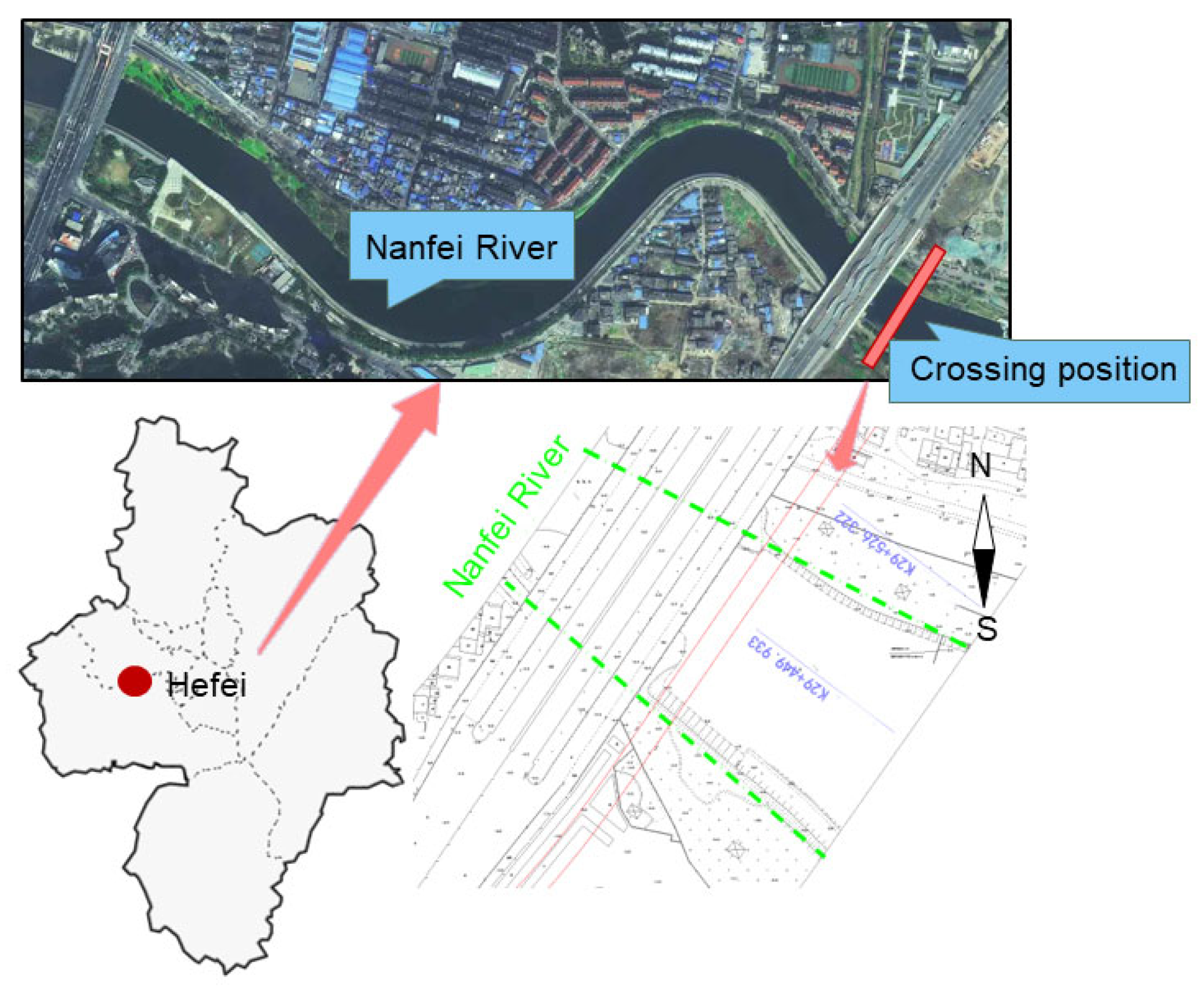

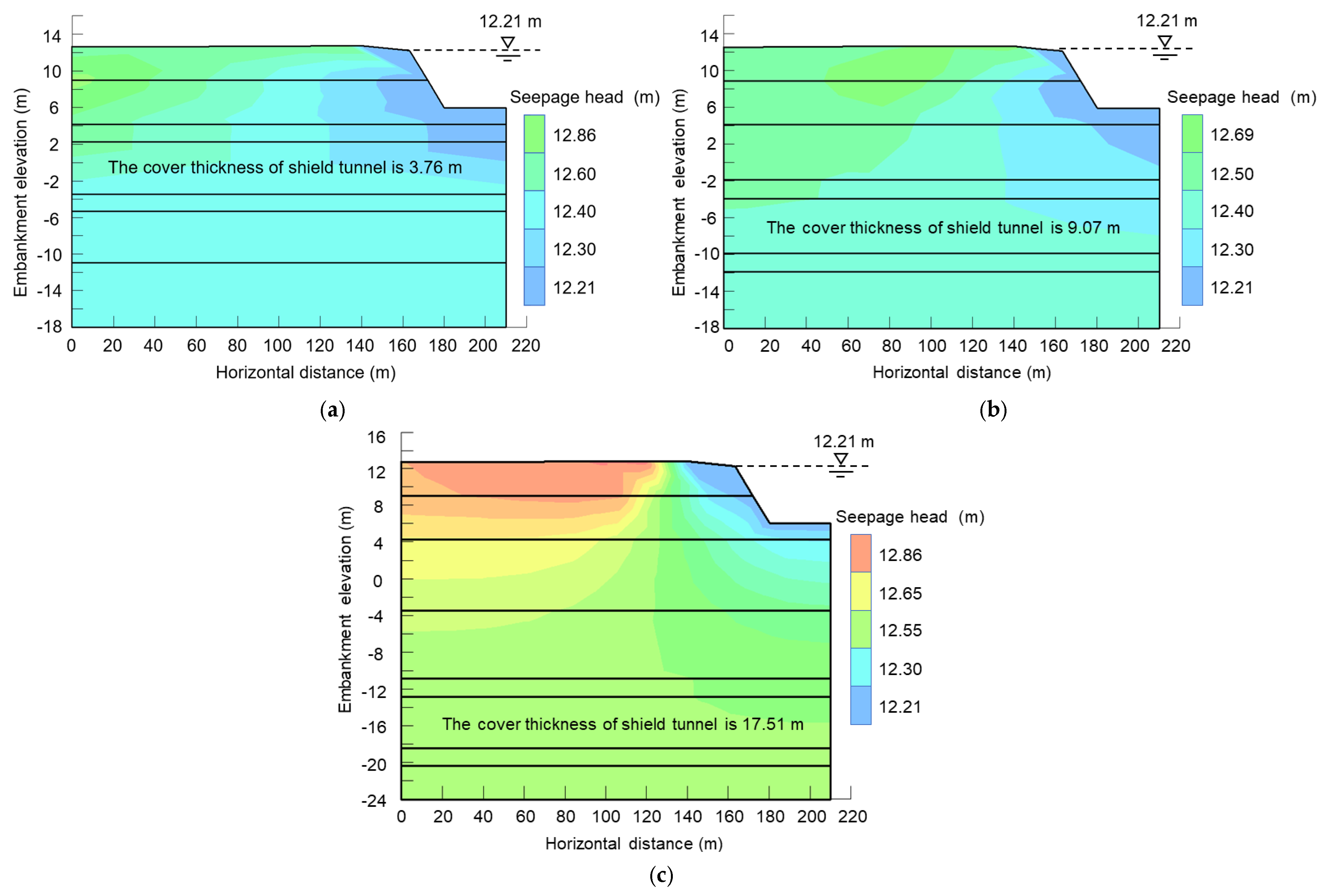
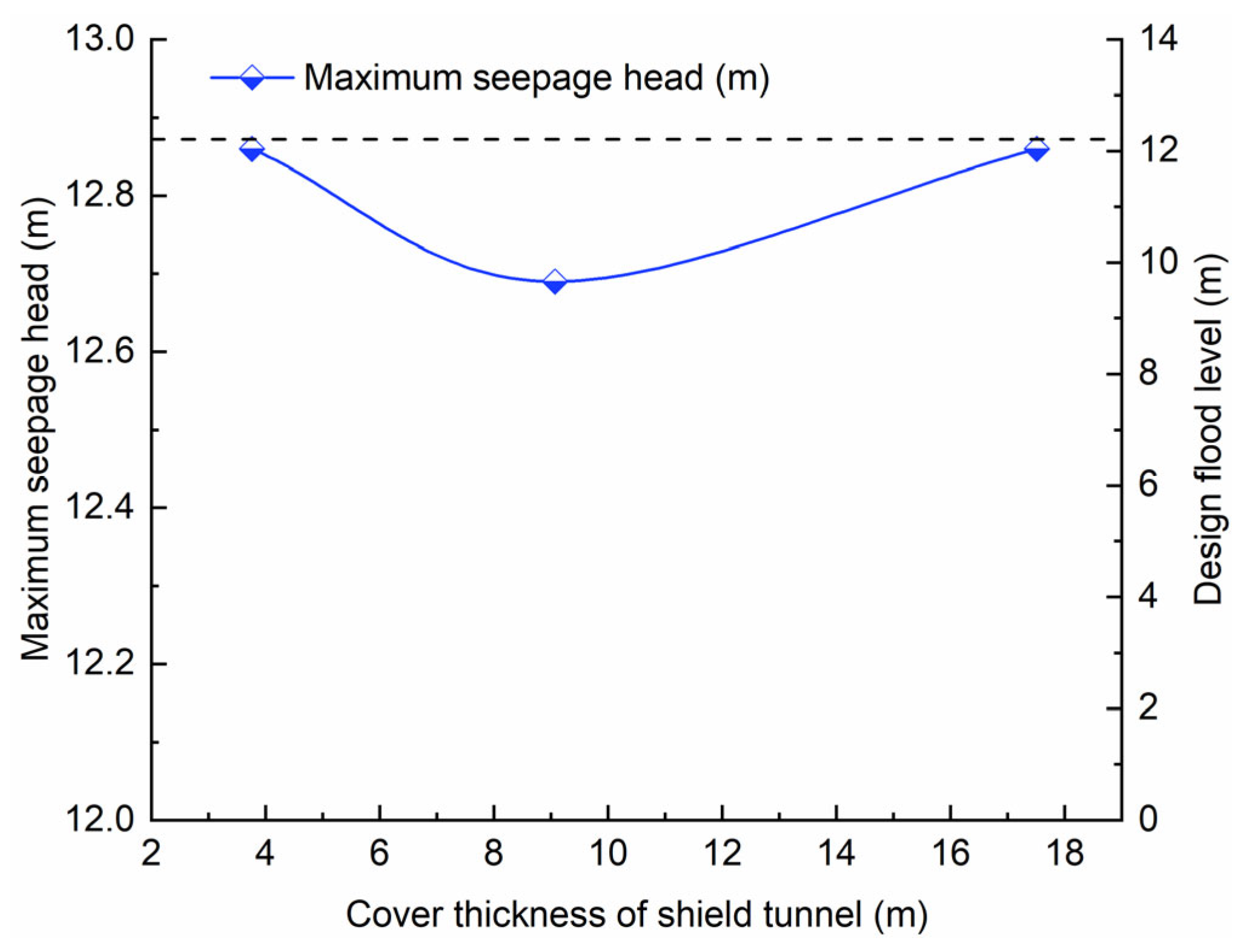
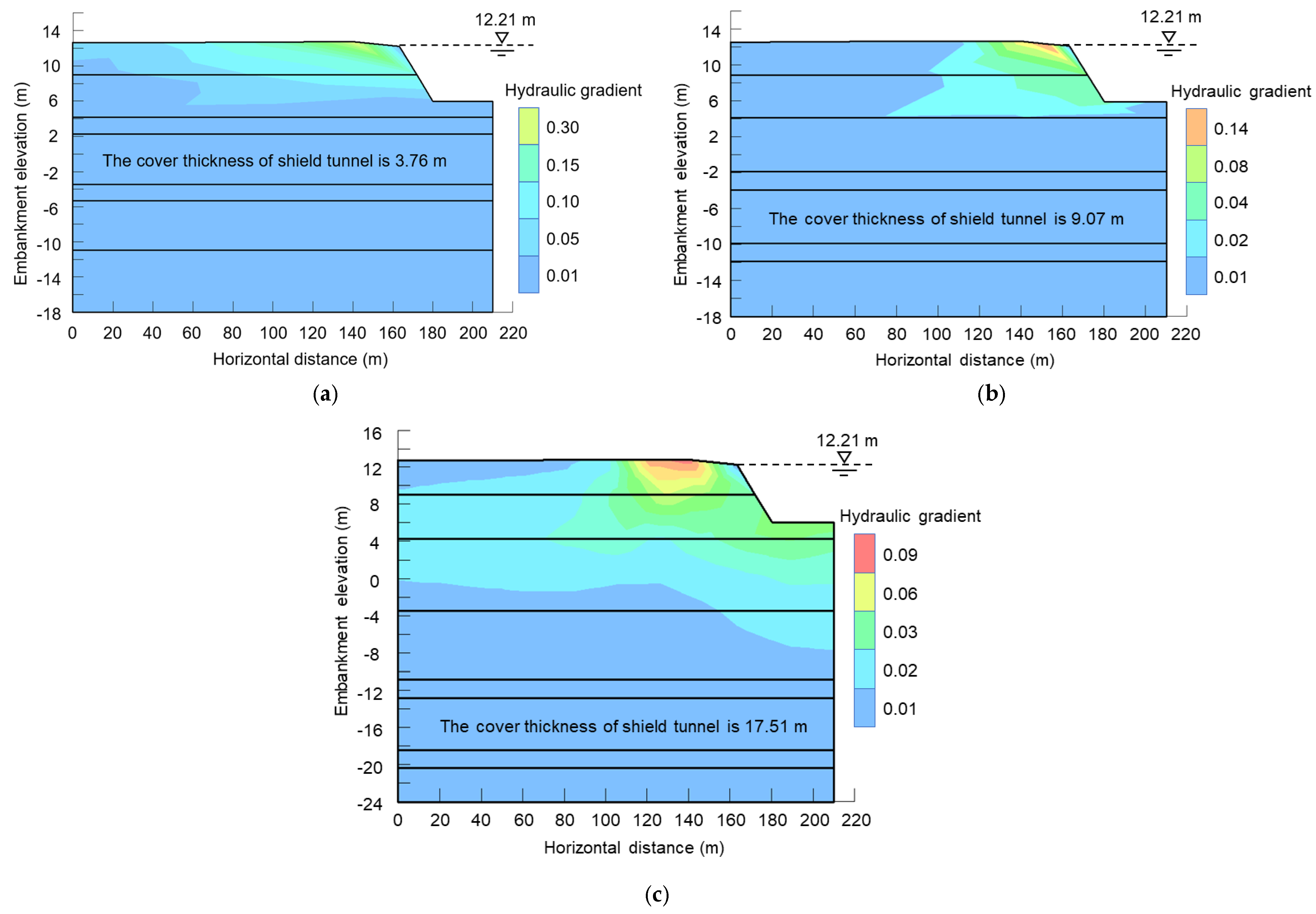

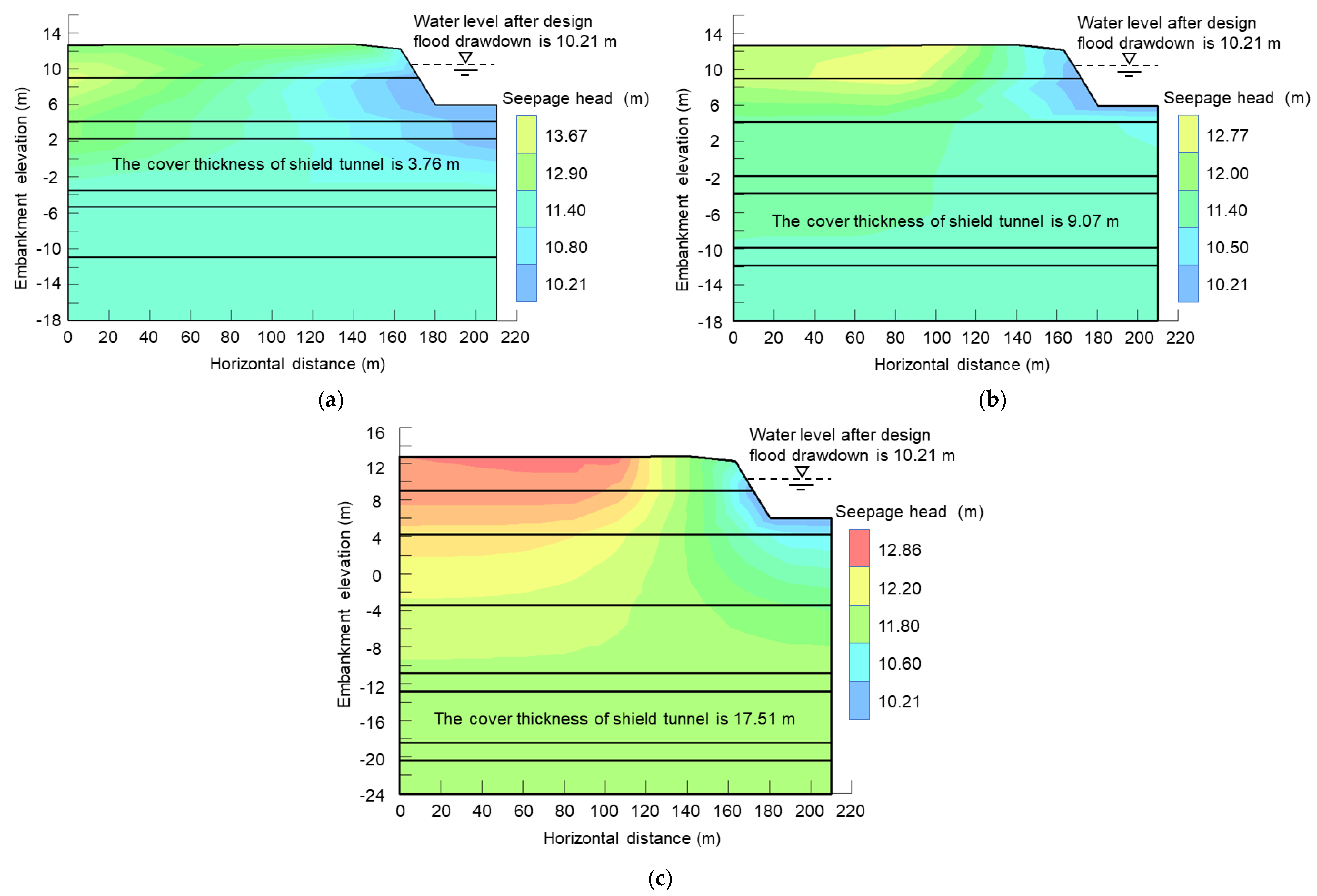

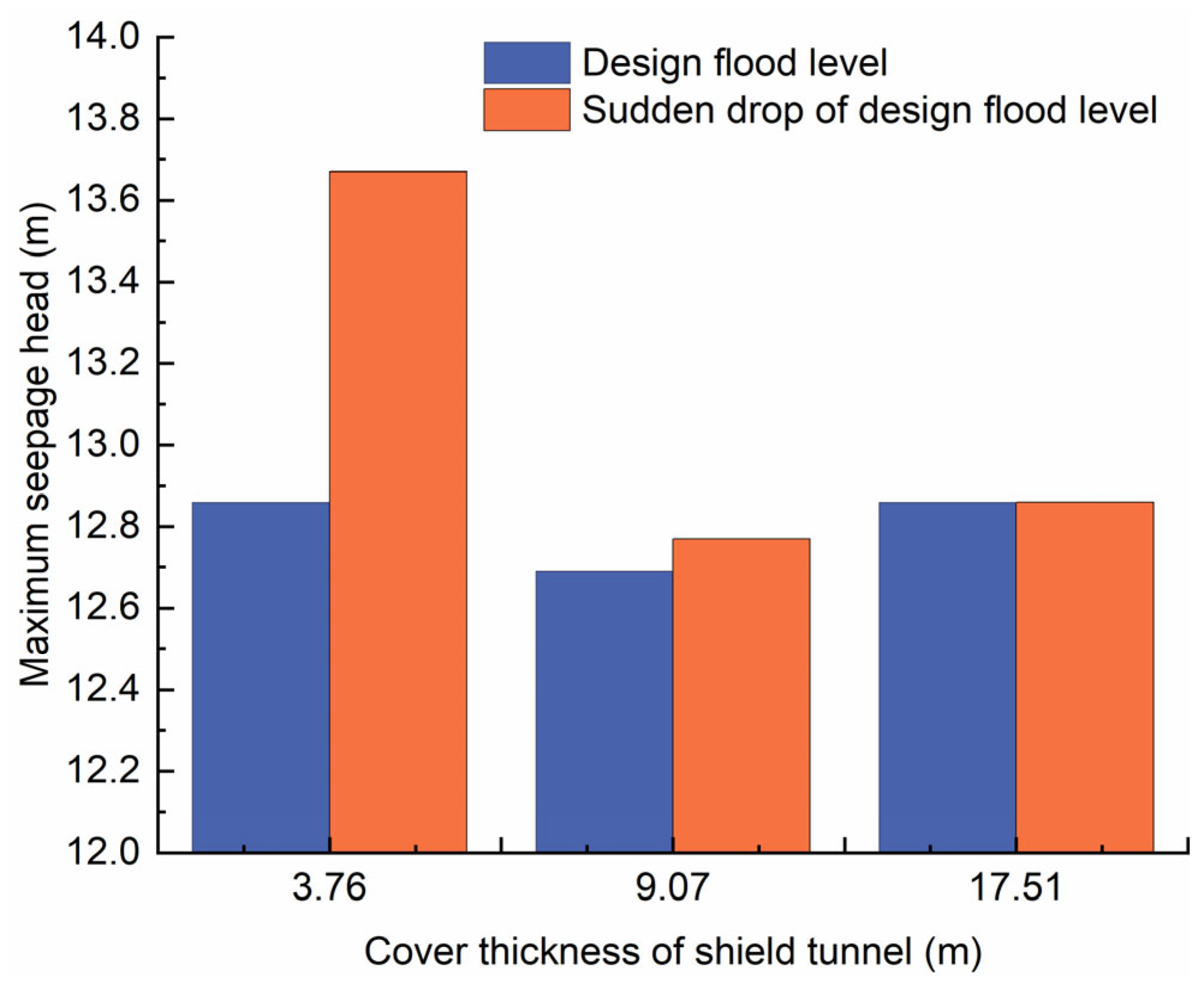



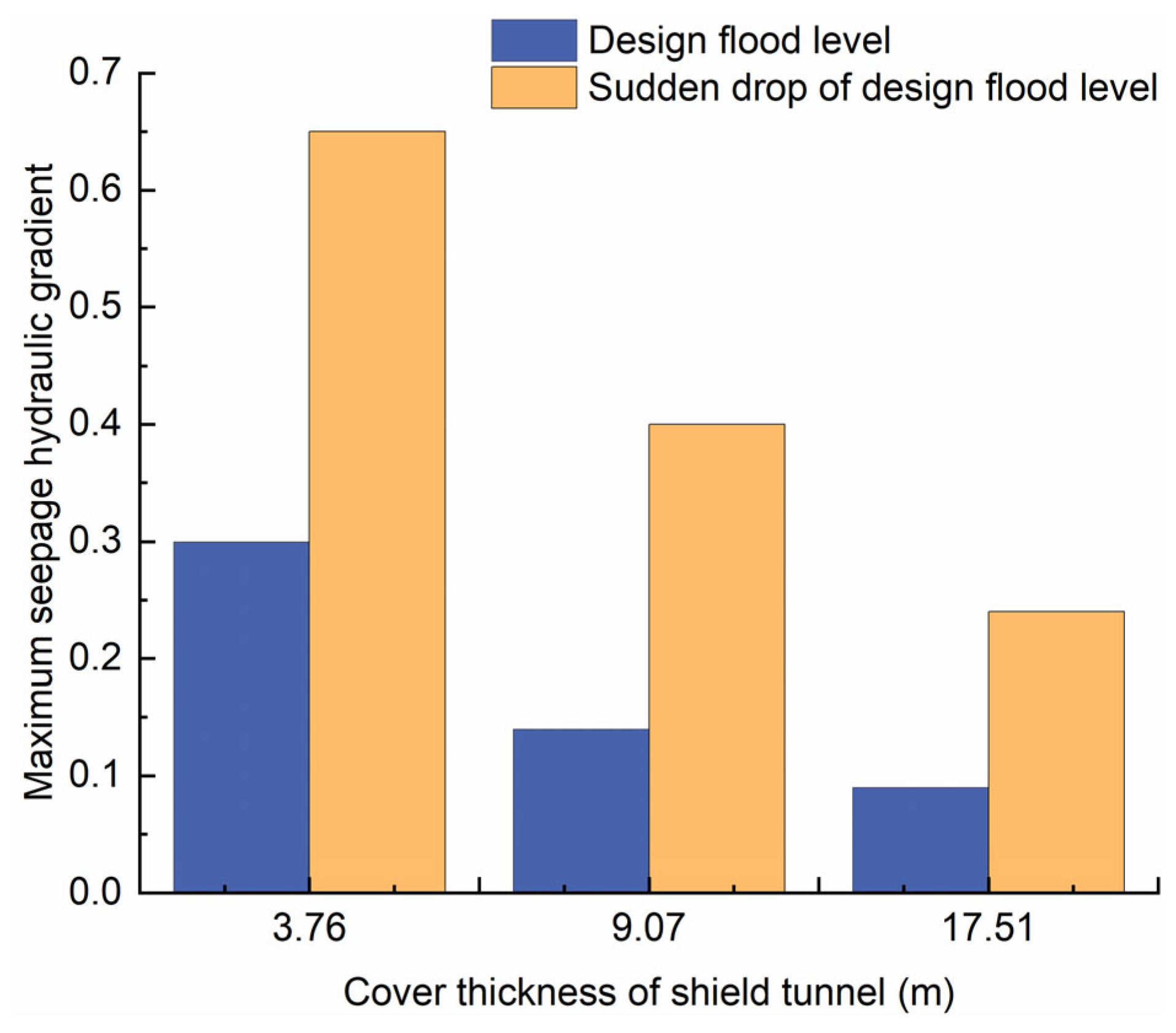
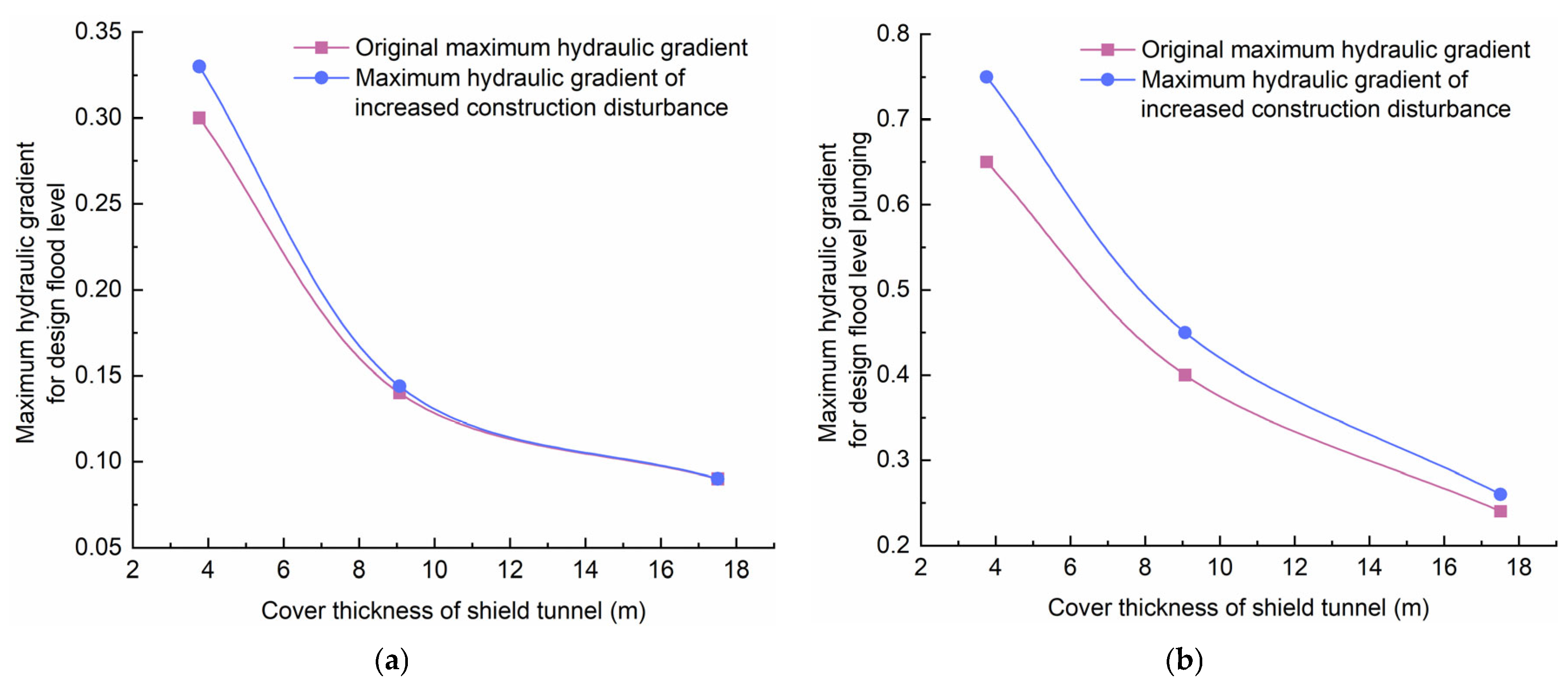
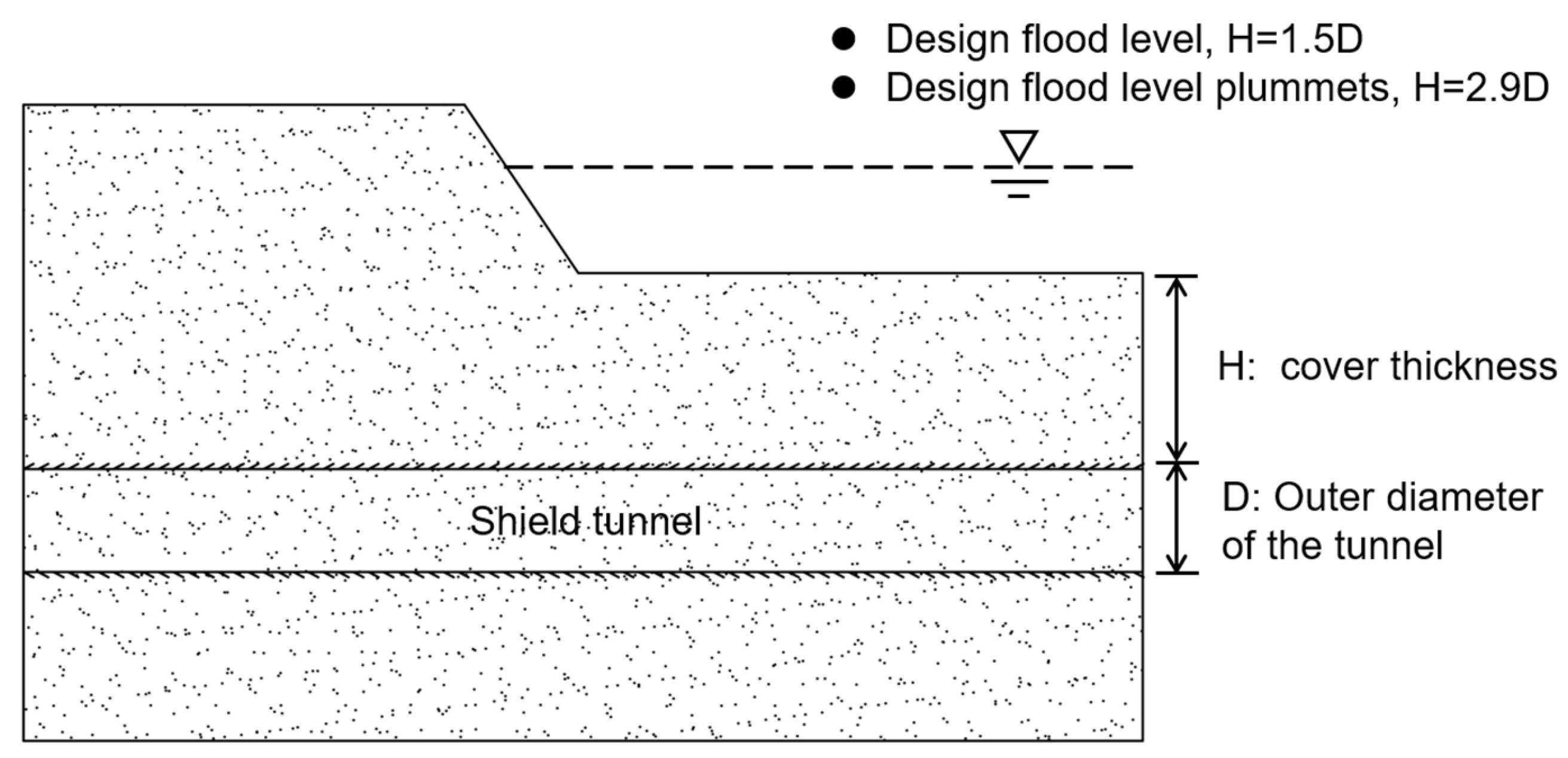
| Materials | E (MPa) | γ (kN∙m−3) | c (kPa) | φ (°) | K (cm∙s−1) | Enhanced K (cm∙s−1) |
|---|---|---|---|---|---|---|
| Miscellaneous fill | 10 | 19.5 | 0 | 9 | 5.0 × 10−5 | - |
| Clay | 55 | 19.8 | 75 | 12.5 | 1.0 × 10−5 | - |
| Silty clay | 18 | 20.1 | 70 | 12 | 2.0 × 10−5 | 2.0 × 10−4 |
| Silt | 19 | 20.5 | 67.5 | 22.5 | 3.0 × 10−5 | 3.0 × 10−4 |
| Silty fine sand | 20 | 21.0 | 0 | 27.5 | 1.0 × 10−4 | 1.0 × 10−3 |
| Shield tunnel | 3.0 × 105 | 25 | - | - | 0 | - |
| Initial Conditions | Descriptions |
|---|---|
| Stabilized seepage condition | 100-year design flood level 12.21 m |
| Unsteady seepage condition | The 100-year design flood level plunges 2 m in 24 h |
| Numbers | Types of Strata Crossed by the Underwater Shield Tunnel | Cladding Thickness (m) |
|---|---|---|
| 1 | Silty clay | 3.76 |
| 2 | Silt | 9.07 |
| 3 | Silty fine sand | 17.51 |
Disclaimer/Publisher’s Note: The statements, opinions and data contained in all publications are solely those of the individual author(s) and contributor(s) and not of MDPI and/or the editor(s). MDPI and/or the editor(s) disclaim responsibility for any injury to people or property resulting from any ideas, methods, instructions or products referred to in the content. |
© 2023 by the authors. Licensee MDPI, Basel, Switzerland. This article is an open access article distributed under the terms and conditions of the Creative Commons Attribution (CC BY) license (https://creativecommons.org/licenses/by/4.0/).
Share and Cite
Shu, W.; Ma, J.; Geng, N.; Xiang, Y.; Ma, S.; Li, X.; Tong, F.; Fang, S. Influences of Underwater Shield Tunnelling on River Embankment Seepage Stability Considering Various Overburden Thickness. Water 2023, 15, 2346. https://doi.org/10.3390/w15132346
Shu W, Ma J, Geng N, Xiang Y, Ma S, Li X, Tong F, Fang S. Influences of Underwater Shield Tunnelling on River Embankment Seepage Stability Considering Various Overburden Thickness. Water. 2023; 15(13):2346. https://doi.org/10.3390/w15132346
Chicago/Turabian StyleShu, Wenyu, Jingjing Ma, Ningning Geng, Yang Xiang, Shiyu Ma, Xian Li, Fang Tong, and Shisheng Fang. 2023. "Influences of Underwater Shield Tunnelling on River Embankment Seepage Stability Considering Various Overburden Thickness" Water 15, no. 13: 2346. https://doi.org/10.3390/w15132346
APA StyleShu, W., Ma, J., Geng, N., Xiang, Y., Ma, S., Li, X., Tong, F., & Fang, S. (2023). Influences of Underwater Shield Tunnelling on River Embankment Seepage Stability Considering Various Overburden Thickness. Water, 15(13), 2346. https://doi.org/10.3390/w15132346






